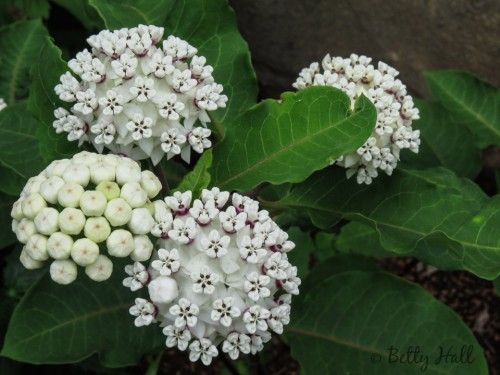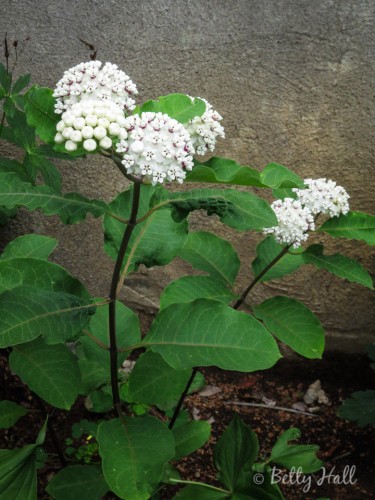I had no idea there was a native white milkweed (Asclepias variegata) until my friend, Patty Hornback, invited me to see the one blooming in her yard. She first saw these plants while camping at Land Between the Lakes in western Kentucky.
The attractive blossoms remind Patty, who is a golfer, of a golf ball covered with beautiful blossoms. 
According to Wildflowers and Ferns of Kentucky by Thomas G. Barnes and S. Wilson Francis, this plant is uncommon but grows throughout the state with the exception of the Bluegrass region. The Monarch Watch website indicates it can be propagated by seeds.
Has anyone else seen white milkweed, and if so, in what areas of the state? Is anyone else growing it? I’m glad to know such a beautiful milkweed is growing wild in Kentucky.



Thank you – had not seen before – lived most of my life in Central Ohio – had tagged Monarchs there decades ago in Urquhart’s Toronto study – moved to Boone County – now settled in Pappy’s Place on Burk Mountain in Harlan County.
Donald, I’m quite impressed that you took part in Urquhart’s Toronto study – a true citizen scientist from way back.
I saw one for the first time last week in the Gorge. We were hiking Koomer Ridge trail and it is on the portion of the trail between the day hikers’ parking area and the parking that is reserved for campers. This is a very short piece of the trail and it is VERY near the parking lot, on the right side of the trail. The bloom was fresh and gorgeous last Friday. I’m sure it’s still lovely now, just five days later. Further along the trail there was a very rare (in KY, anyway) orchid called spreading pogonia. We saw about 7 of these, one at a time, along the Koomer Ridge trail between the Hidden Arch trail and where Koomer joins the Rough Trail. Totally exciting to see these, never seen ’em before. Worth the trip, for sure.
Ann, thanks. I’m really glad to know that white milkweed grows in the Gorge. Including the 7(!) spreading pogonia orchids, I’d say you hit the jackpot.
You’ll see spreading pogonia (Cleistes divaricata) on page 202 of Tom Barnes’ book, ‘Wildflowers and Ferns of Kentucky’. I do miss Tom so much…
I happened upon this flower this past weekend while hiking Pilot Knob SNP. I too had no idea that there was such thing as a white milkweed. I was thrilled to see it!
Marsha, glad to know you found it a Pilot Knob. That’s 3 different sighting in 3 different area. It is a beauty isn’t it?
What a pretty milkweed flower, and such an amazing form ……. i really like it! Lovely photo Betty, and well done Patty for having such a beauty growing in her yard.
How lovely! I’ve never seen one either but would love to have it in our garden. We have regular milkweed in the hay fields but the man who leases the fields sprays them with weed killer. The white flowers would look lovely in the flower garden and I assume would provide habitat for the monarch butterflies?
Jan, does the man who sprays the milkweed understand that milkweeds are the only plants the milkweed caterpillars can eat? Do you suppose he could be persuaded to leave at least a few of them? My brother used to do the same thing. He now has a patch that he saves for the monarchs and has thoroughly enjoyed the caterpillars and the adults that he has seen. And yes, all milkweeds provide habitat for monarchs as well as many other pollinators. I wish more folks understood the importance of milkweeds. The five different ones in our backyard are among my favorite plants.
Hello! Does anyone know of a source where I could purchase the seeds for Asclepias variegata (redring milkweed)? Thank you.
Sorry, Kathy, I can’t help you. Mine bloomed for the first time this year. However, I’ve heard you need two or more plants for viable seeds.
I live in Middle Tennessee (about 70 miles southwest of Nashville) and I found some blooming in my side yard today. I hope it doesn’t take 2 plants for viable seed because I want some and will watch the plant very carefully.
Lynne, what a nice surprise for you! I’ve been told you do need two plants to get viable seeds. However, I could not find any information on the internet and I didn’t find any source of seeds. I have only one plant and I didn’t get seeds last fall (my first year). If I get more information, will let you know.
I will also let you know about any results here
Greetings from Toronto Ontario Canada!
For a number of years, I have been planting for pollinators, with a focus on Milkweeds for the Monarchs.
The beautiful Asclepias variegata is native to our region, but is currently listed as ‘extirpated’ (extinct in our region). I have been searching for seeds for the past few years, with no luck….
I would be enormously grateful if you would consider sending me a few seeds, if your plants produce any.
I would make it my mission to bring the Red-ringed Milkweed back to Ontario!
Michelle, Glad to know of your help to pollinators and Monarchs in Toronto. Sorry to say, I do not have any seeds for Asclepias variegata. You need more than on plant to get seeds and so far, I have only one. It came from western Kentucky where they grow along the roads. I found one source on the web – $75 for 13 seeds plus $10 shipping!!! I will keep you in mind and will be glad to mail seeds to you if I find a source. Good luck with your mission.
I saw a few of these blooming roadside in Louisa, Virginia just the other day, and a few years ago saw a lone plant on my property. It never returned. There is wild milkweed everywhere around me – the pink/red variety – and it’s just now starting to get a foothold on my property. It had two or three plants last year, and I have six or seven this year. I’m hoping they’ll produce seed and I’ll see more. Does anyone know the Latin name of the white variety?
Alica, Thanks for your comment. The white one in Kentucky is(Asclepias variegata).